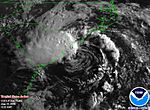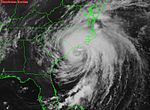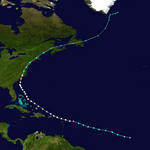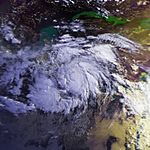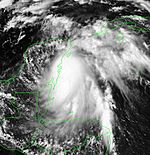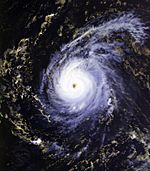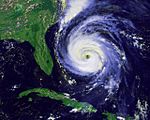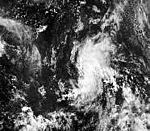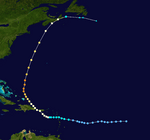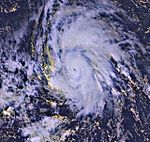1996 Atlantic hurricane season facts for kids
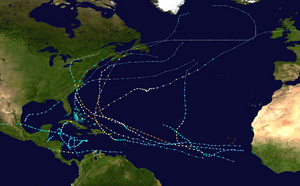 |
|
| Season summary map | |
| First storm formed | June 17, 1996 |
|---|---|
| Last storm dissipated | November 26, 1996 |
| Strongest storm | Edouard – 933 mbar (hPa) (27.56 inHg), 145 mph (230 km/h) |
| Total depressions | 13 |
| Total storms | 13 |
| Hurricanes | 9 |
| Major hurricanes (Cat. 3+) | 6 |
| Total fatalities | 256 |
| Total damage | ~ $8.41 billion (1996 USD) |
| Atlantic hurricane seasons 1994, 1995, 1996, 1997, 1998 |
|
The 1996 Atlantic hurricane season was a busy time for storms in the Atlantic Ocean. It officially started on June 1, 1996, and ended on November 30, 1996. During this period, tropical storms and hurricanes are most likely to form. In 1996, the last storm, Hurricane Marco, finished on November 24. This season had many storms, but not as many as the year before. However, it was more active than the next year.
Contents
- Meet the Storms of 1996
- Tropical Storm Arthur: The First Storm
- Hurricane Bertha: The First Hurricane
- Hurricane Cesar: Crossing Continents
- Hurricane Dolly: Two Landfalls
- Hurricane Edouard: The Strongest Storm
- Hurricane Fran: A Costly Storm
- Tropical Storm Gustav: Short-Lived
- Hurricane Hortense: Impacting Islands
- Hurricane Isidore: Far Out at Sea
- Other Storms of 1996
- Unused Storm Names
- Retired Storm Names
- Images for kids
- See also
Meet the Storms of 1996
Tropical Storm Arthur: The First Storm
| Tropical storm (SSHS) | |||
|---|---|---|---|
|
|||
| Duration | June 17 – June 21 | ||
| Intensity | 50 mph (85 km/h) (1-min), 990 mbar (hPa) | ||
Tropical Storm Arthur was the very first tropical storm of 1996. It began on June 17 in the Bahamas. At first, it was a weak storm called Tropical Depression One.
By June 19, it grew stronger and became Tropical Storm Arthur. It then moved towards Cape Lookout, North Carolina, where it made landfall. Arthur was a weak storm when it hit land. It soon moved back into the Atlantic Ocean and faded away on June 21. Arthur did not cause any deaths and only about $1 million in damage.
Hurricane Bertha: The First Hurricane
| Category 3 hurricane (SSHS) | |||
|---|---|---|---|
|
|||
| Duration | July 5 – July 14 | ||
| Intensity | 115 mph (185 km/h) (1-min), 960 mbar (hPa) | ||
Hurricane Bertha was the first hurricane of the 1996 season. It started on July 5 near the Cape Verde Islands. On the same day, it became Tropical Storm Bertha.
By July 7, Bertha had grown into a hurricane. It passed by Antigua and Sint Maarten, causing some damage. Bertha then moved along the edges of the islands in the Bahamas. On July 12, Hurricane Bertha made landfall in North Carolina as a strong Category 2 hurricane. It quickly became weaker and disappeared on July 14 as it entered Canada. Bertha caused 9 deaths and about $335 million in damage.
Hurricane Cesar: Crossing Continents
| Category 1 hurricane (SSHS) | |||
|---|---|---|---|
|
|||
| Duration | July 24 – July 29 | ||
| Intensity | 85 mph (140 km/h) (1-min), 985 mbar (hPa) | ||
Hurricane Cesar began off the coast of Venezuela on July 24 as a tropical depression. It slowly gained strength, becoming a tropical storm the next day. By July 27, it was a hurricane.
On July 28, Cesar made landfall as a hurricane in Nicaragua. It weakened to a tropical storm over land. However, it reached the Pacific Ocean and later became Hurricane Douglas. Hurricane Cesar caused 77 deaths and about $206 million in damage.
Hurricane Dolly: Two Landfalls
| Category 1 hurricane (SSHS) | |||
|---|---|---|---|
|
|||
| Duration | August 19 – August 26 | ||
| Intensity | 80 mph (130 km/h) (1-min), 989 mbar (hPa) | ||
Hurricane Dolly started as Tropical Depression Four near Jamaica. It quickly became Tropical Storm Dolly. Soon after, it turned into Hurricane Dolly just before hitting the Yucatan Peninsula on August 20.
Dolly weakened over land and entered the southern Gulf of Mexico as a tropical depression. It then quickly grew stronger again, becoming a tropical storm. Just before making another landfall in Mexico, it became Hurricane Dolly again on August 23. The storm weakened a lot over Mexico and ended on August 26. It caused about 14 deaths in Mexico.
Hurricane Edouard: The Strongest Storm
| Category 4 hurricane (SSHS) | |||
|---|---|---|---|
|
|||
| Duration | August 19 – September 3 | ||
| Intensity | 145 mph (230 km/h) (1-min), 933 mbar (hPa) | ||
Hurricane Edouard was the most powerful hurricane of the 1996 Atlantic hurricane season. It started as Tropical Depression Five near Cape Verde on August 19. It took a few days for it to become Tropical Storm Edouard, which happened on August 22. By the next day, it had grown into Hurricane Edouard.
Hurricane Edouard quickly became very strong, reaching Category 4 hurricane status from August 24 to 28. After this, it weakened a little to a Category 3 hurricane. It then moved north. On September 2, Hurricane Edouard passed only 90 miles south of Massachusetts. By the next day, Hurricane Edouard had ended. Edouard caused 2 deaths and about $3.5 million in damage.
Hurricane Fran: A Costly Storm
| Category 3 hurricane (SSHS) | |||
|---|---|---|---|
|
|||
| Duration | August 23 – September 8 | ||
| Intensity | 120 mph (195 km/h) (1-min), 946 mbar (hPa) | ||
Fran started on August 23 as Tropical Depression Six. It grew stronger slowly because Hurricane Edouard was nearby. The depression became Tropical Storm Fran on August 27.
Fran became a hurricane on August 29. It weakened back to a tropical storm on August 30, but then became a hurricane again on August 31. Hurricane Fran did not get much stronger until it started moving more to the north. By September 5, it made landfall in Cape Fear, North Carolina, as a Category 3 hurricane. It ended on September 8. Fran caused the deaths of 26 people and about $3.2 billion in damage.
Tropical Storm Gustav: Short-Lived
| Tropical storm (SSHS) | |||
|---|---|---|---|
|
|||
| Duration | August 26 – September 2 | ||
| Intensity | 45 mph (75 km/h) (1-min), 1005 mbar (hPa) | ||
On August 26, Tropical Depression Seven began. It slowly grew and became Tropical Storm Gustav. It moved northwest but did not get any stronger. This was because of the large Hurricane Fran nearby and something called "wind shear." Wind shear also caused it to end on September 2.
Hurricane Hortense: Impacting Islands
| Category 4 hurricane (SSHS) | |||
|---|---|---|---|
|
|||
| Duration | September 3 – September 15 | ||
| Intensity | 140 mph (220 km/h) (1-min), 935 mbar (hPa) | ||
Hortense started on September 3 as the eighth tropical depression of 1996. It slowly gained strength, becoming Tropical Storm Hortense four days later, on September 7. As a tropical storm, it moved through the Leeward Islands and into the Caribbean Sea.
It continued to slowly strengthen, becoming Hurricane Hortense on September 9. Hurricane Hortense made landfall on the southwestern part of Puerto Rico. This caused about $155 million in damage and the deaths of 18 people. It also moved along the coast of the Dominican Republic, where it caused 3 deaths.
Hortense soon went back into the Atlantic Ocean and quickly became much stronger. By September 13, it was a powerful Category 4 hurricane with winds of 140 miles per hour. Hortense started moving faster but also weakened at the same time. Finally, by September 15, it made another landfall in Nova Scotia. In Nova Scotia, it caused about $3 million in damage. Hurricane Hortense ended later on September 15.
Hurricane Isidore: Far Out at Sea
| Category 3 hurricane (SSHS) | |||
|---|---|---|---|
|
|||
| Duration | September 24 – October 1 | ||
| Intensity | 115 mph (185 km/h) (1-min), 960 mbar (hPa) | ||
Isidore started on September 24, several hundred miles south of Cape Verde. It moved westward and later reached its strongest point as a Category 3 hurricane. Hurricane Isidore then began heading north after becoming a Category 3 hurricane. Isidore weakened and ended on October 1.
Other Storms of 1996
- Tropical Storm Josephine
- Tropical Storm Kyle
- Hurricane Lili
- Possible storm
- Hurricane Marco
The 1996 Atlantic hurricane season had 13 named storms in total. Out of these, 9 became hurricanes, and 6 of those were major hurricanes (Category 3 or higher).
Unused Storm Names
Each year, a list of names is ready for storms. In 1996, there were 8 names that were not needed:
- Nana (unused)
- Omar (unused)
- Paloma (unused)
- Rene (unused)
- Sally (unused)
- Teddy (unused)
- Vicky (unused)
- Wilfred (unused)
Retired Storm Names
After a hurricane season, if a storm causes a lot of damage or deaths, its name might be "retired." This means the name won't be used again for another storm. In the spring of 1997, the names Cesar, Fran, and Hortense were retired because of their big impact. New names were chosen to replace them: Cristobal, Fay, and Hanna. These new names were first used in the 2002 season.
|
Tropical cyclones of the 1996 Atlantic hurricane season |
|||||||||||||||||||||||||||||
|
|
|
||||||||||||||||||||||||||||
|
|
|||||||||||||||||||||||||||||
|
Images for kids
See also
 In Spanish: Temporada de huracanes en el Atlántico de 1996 para niños
In Spanish: Temporada de huracanes en el Atlántico de 1996 para niños


